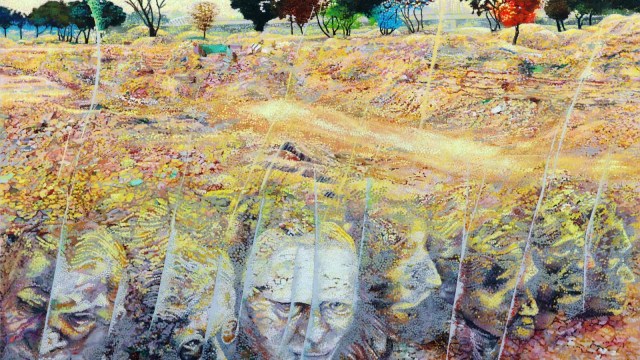Rubble to canvas: How artist Paribartana Mohanty brings to life Delhi’s demolished Kathputli Colony
Mohanty gives voice to this demolition in his exhibition, ‘I Rescued Speed Altogether’, at the Shrine Empire gallery in New Delhi.
 Mohanty captures the erasure of community memory in ‘Maidan (Field)’. (Photo credit: Paribartana Mohanty)
Mohanty captures the erasure of community memory in ‘Maidan (Field)’. (Photo credit: Paribartana Mohanty)In Salman Rushdie’s Midnight’s Children, Saleem Sinai finds refuge in a ‘moving slum’, before it is razed by the government during the Emergency. Fiction meets reality in Delhi’s Kathputli Colony, which was bulldozed in 2017 to make way for the city’s ‘first in-situ slum rehabilitation project’.
Giving voice to this demolition is artist Paribartana Mohanty’s exhibition, ‘I Rescued Speed Altogether’, at the Shrine Empire gallery in New Delhi. The show presents 12 paintings and three videos that document site visits using Impressionist and pointillist techniques — a slow cooking of how demolitions happen overnight in cities.
While Mohanty’s work ‘Phida (Platform)’ is bathed in gritty browns and ochre, it testifies to the ruin and desolation that razed brick and mortar bring. Each dot on the canvas rises to mark its presence on a hazy landscape that nobody can claim as home anymore.
 ‘Phida (Platform)’ testifies to the ruin and desolation that razed brick and mortar bring. (Photo credit: Paribartana Mohanty)
‘Phida (Platform)’ testifies to the ruin and desolation that razed brick and mortar bring. (Photo credit: Paribartana Mohanty)
On one such site visit, Mohanty says, he recalls women seated between the rubble. “There were grandmothers, sisters, daughters sitting on broken bricks and plaster while the men negotiated with those who came with bulldozers to bring down their houses. They were collecting iron rods, remains of their broken homes, claiming every last bit of ‘property’; it wasn’t garbage for them,” says Mohanty.
A 2013 Centre for Policy Research report records how the 1970s saw this West Delhi settlement grow from puppeteers and musicians to include magicians, acrobats, folk artistes, and craftspeople. However, when the time did come for redevelopment, the residents were caught unaware. Some of them “found out about the DDA rehabilitation project when dignitaries like the chief minister gathered to lay a foundation stone at the edge of the colony”.
Mohanty captures this in the erasure of community memory in ‘Maidan (Field)’, where, against the backdrop of a cricket pitch, there are faces drawn out to capture the presence of humans on an otherwise bare landscape.
In ‘Sataha (Surface)’, a fiery orange foreground envelopes a black hole, suggesting how often slums are eaten up by a city’s plan for renewal, wiping away any trace of history.
 Sataha (Surface)’ suggests how often slums are eaten up by a city’s plan for renewal. (Photo credit: Paribartana Mohanty)
Sataha (Surface)’ suggests how often slums are eaten up by a city’s plan for renewal. (Photo credit: Paribartana Mohanty)
Cultural theorist Santhosh Sadanandan, in his commentary on the exhibition, writes: “What is dismantled is not only brick and tarpaulin but the right to opacity, to dwell otherwise. In these cycles of eviction, the poor are simply not removed; they are rewritten, folded into the language of failure, failed subjects, incomplete citizens, living reminders of a dream the nation cannot quite awaken from.”
Sadanandan also writes about “the nation obsessed with image management, where beautification serves as a proxy for governance”.
Mohanty, who lives and works in New Delhi and Bhubaneswar, is a visiting faculty, Department of Art, Media, and Performance, at Shiv Nadar University.
 Phawara (Fountain). credit to the artist, Paribartana Mohanty. (Photo credit: Paribartana Mohanty)
Phawara (Fountain). credit to the artist, Paribartana Mohanty. (Photo credit: Paribartana Mohanty)
The exhibition is a product of eight years of his reading of the city, how we navigate, access and dwell in the city, often oblivious to the many erasures within it — from a change of street names to demolitions and parks turning into parking lots.
Often in masterplans, slums are seen in 2D, where people’s lives are flattened by a lack of empathy and collective consciousness. Kathputli Colony, like numerous other unorganised colonies, carried within it the possibilities of entrepreneurship, skill, heritage, and history.
As British-American academic David Harvey says, “The right to the city is far more than the individual liberty to access urban resources: it is a right to change ourselves by changing the city”.
 Finn, the Human. (Photo credit: Paribartana Mohanty)
Finn, the Human. (Photo credit: Paribartana Mohanty)
The exhibition is an attempt to acknowledge that we can do better by not being in denial and allowing ourselves to wake up to the memory of a past we must treasure.
The show closes on September 20.








